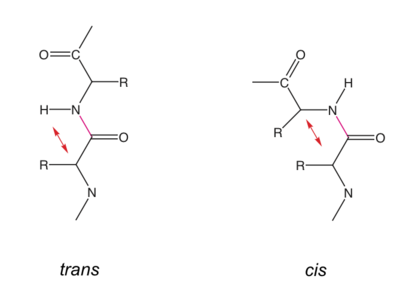User:Tilman Schirmer/Sandbox 99
From Proteopedia
Contents |
Peptide bond
|
The (highlight in ) formation is a condensation reaction between the carboxyl group of the amino acid i and the amino group of the amino acid i+1.
The peptide bond is a resonance structure between two limiting states. Therefore the N-C bond has a partial double bond character and the atoms/groups Cα, HN, C, C=O are within one plane. Peptide bonds are usually in trans conformation (ω torsion angle= 180°). In cis-conformation, there would be steric hindrance between Cα,i and Cα,i+1.

Cis conformation has been observed almost exclusively for peptide bonds preceding a Pro residue (Xaa - Pro), see below.
is defined by the four atoms φ = C - N - Cα - C (in green).
is defined by the four atoms ψ = N - Cα - C - N (in green).
is defined by the four atoms ω = Cα - C - N - Cα (in green).
Cis peptide bonds
The ω torsion angle can adopt a value close to 0° (cis-conformation), when a Pro residue is the following residue (Xaa-Pro peptide bond). In this situation a and a are similarily unfavorable, since there is a steric clash between Cα,i with Cα,i+1 or Cδ,i+1, respectively. Conversely, the carbonyl O of residue i is in tight juxtaposition with Cδ,i+1 or Cα,i+1 (note that latter tight contact occurs in any trans peptide bond).
Torsion angle φ restricted for Pro
Due to the ring closure of the Pro side-chain the torsion around the N - Cα is considerably to a value between -50° to -90°.
References
- Chakrabarti P, Pal D. The interrelationships of side-chain and main-chain conformations in proteins. Prog Biophys Mol Biol. 2001;76(1-2):1-102. PMID:11389934
Next Topic
Secondary structure of proteins http://proteopedia.org/wiki/index.php/User:Tilman_Schirmer/Sandbox_100
